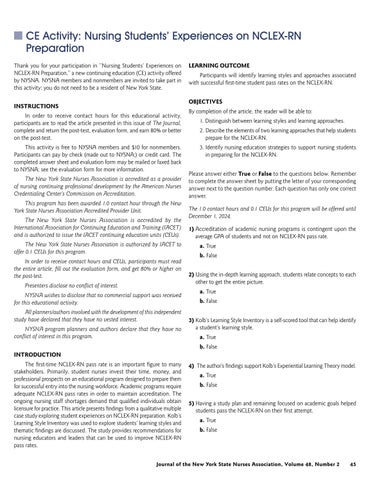n CE Activity: Nursing Students’ Experiences on NCLEX-RN Preparation
Thank you for your participation in “Nursing Students’ Experiences on NCLEX-RN Preparation,” a new continuing education (CE) activity offered by NYSNA. NYSNA members and nonmembers are invited to take part in this activity; you do not need to be a resident of New York State.
LEARNING OUTCOME Participants will identify learning styles and approaches associated with successful first-time student pass rates on the NCLEX-RN. OBJECTIVES
INSTRUCTIONS In order to receive contact hours for this educational activity, participants are to read the article presented in this issue of The Journal, complete and return the post-test, evaluation form, and earn 80% or better on the post-test. This activity is free to NYSNA members and $10 for nonmembers. Participants can pay by check (made out to NYSNA;) or credit card. The completed answer sheet and evaluation form may be mailed or faxed back to NYSNA; see the evaluation form for more information. The New York State Nurses Association is accredited as a provider of nursing continuing professional development by the American Nurses Credentialing Center’s Commission on Accreditation. This program has been awarded 1.0 contact hour through the New York State Nurses Association Accredited Provider Unit. The New York State Nurses Association is accredited by the International Association for Continuing Education and Training (IACET) and is authorized to issue the IACET continuing education units (CEUs). The New York State Nurses Association is authorized by IACET to offer 0.1 CEUs for this program. In order to receive contact hours and CEUs, participants must read the entire article, fill out the evaluation form, and get 80% or higher on the post-test. Presenters disclose no conflict of interest. NYSNA wishes to disclose that no commercial support was received for this educational activity. All planners/authors involved with the development of this independent study have declared that they have no vested interest. NYSNA program planners and authors declare that they have no conflict of interest in this program.
By completion of the article, the reader will be able to: 1. Distinguish between learning styles and learning approaches. 2. Describe the elements of two learning approaches that help students prepare for the NCLEX-RN. 3. Identify nursing education strategies to support nursing students in preparing for the NCLEX-RN. Please answer either True or False to the questions below. Remember to complete the answer sheet by putting the letter of your corresponding answer next to the question number. Each question has only one correct answer. The 1.0 contact hours and 0.1 CEUs for this program will be offered until December 1, 2024. 1) Accreditation of academic nursing programs is contingent upon the average GPA of students and not on NCLEX-RN pass rate. a. True b. False 2) Using the in-depth learning approach, students relate concepts to each other to get the entire picture. a. True b. False 3) Kolb’s Learning Style Inventory is a self-scored tool that can help identify a student’s learning style. a. True b. False
INTRODUCTION The first-time NCLEX-RN pass rate is an important figure to many stakeholders. Primarily, student nurses invest their time, money, and professional prospects on an educational program designed to prepare them for successful entry into the nursing workforce. Academic programs require adequate NCLEX-RN pass rates in order to maintain accreditation. The ongoing nursing staff shortages demand that qualified individuals obtain licensure for practice. This article presents findings from a qualitative multiple case study exploring student experiences on NCLEX-RN preparation. Kolb’s Learning Style Inventory was used to explore students’ learning styles and thematic findings are discussed. The study provides recommendations for nursing educators and leaders that can be used to improve NCLEX-RN pass rates.
4) The author’s findings support Kolb’s Experiential Learning Theory model. a. True b. False 5) Having a study plan and remaining focused on academic goals helped students pass the NCLEX-RN on their first attempt. a. True b. False
Journal of the New York State Nurses Association, Volume 48, Number 2
45

